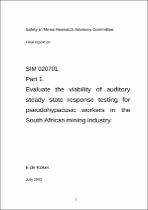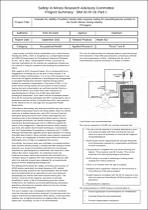 ResearchSpace
ResearchSpace
Evaluate the viability of auditory steady state response testing for pseudohypacusic workers in the South African mining industry
JavaScript is disabled for your browser. Some features of this site may not work without it.
- ResearchSpace
- →
- Research Publications/Outputs
- →
- Conference Publications
- →
- View Item
| dc.contributor.author |
De Koker, E

|
|
| dc.date.accessioned | 2007-10-09T12:32:01Z | |
| dc.date.available | 2007-10-09T12:32:01Z | |
| dc.date.issued | 2003-07 | |
| dc.identifier.citation | De Koker, E. 2003. Evaluate the viability of auditory steady state response testing for pseudohypacusic workers in the South African mining industry. Safety in Mines Research Advisory Committee, SIM 020701, July 2003, pp 79 | en |
| dc.identifier.uri | http://hdl.handle.net/10204/1305 | |
| dc.description | This report consists of 2 papers: report summary & Main content | en |
| dc.description.abstract | Large numbers of South African mineworkers incur noise-induced hearing loss (NIHL), which is recognized as a compensable disease by COIDA (Compensation for Occupational Injuries and Diseases, 1993 (Act 130 of 1993)). The prevalence of NIHL is such that its financial implications for the industry are substantial, threatening the viability of marginal operations and eroding the profitability of others. Of even greater concern is the impact on workers’ quality of life. In a review of the literature, it was found that the highest prevalence of pseudohypacusis (exaggerated or simulated hearing loss) has been reported among workers eligible for monetary compensation in the event of NIHL. In the South African mining industry, the occurrence of noise-induced hearing loss and compensation are well documented. Franz (2001) found that audiologists consulting to mines’ Occupational Health Departments frequently cited pseudohypacusis as the greatest impediment to assessing the true hearing status of patients referred to them. Accordingly, the present study was undertaken to evaluate auditory steady state response (ASSR) testing, as a means of accurately estimating the true hearing thresholds for pseudohypacusic mineworkers who may have NIHL, even without their active cooperation. An exploratory study was conducted to assess various test protocols and instruments for a normative group of subjects with noise-induced hearing loss, after which a selected protocol was evaluated for an experimental group of workers displaying pseudohypacusis | en |
| dc.language.iso | en | en |
| dc.subject | SIMRAC | en |
| dc.subject | Pseudohypacusic | en |
| dc.subject | SIM 020701 | en |
| dc.subject | Auditory steady state response | en |
| dc.subject | ASSR | en |
| dc.title | Evaluate the viability of auditory steady state response testing for pseudohypacusic workers in the South African mining industry | en |
| dc.type | Conference Presentation | en |
| dc.identifier.apacitation | De Koker, E. (2003). Evaluate the viability of auditory steady state response testing for pseudohypacusic workers in the South African mining industry. http://hdl.handle.net/10204/1305 | en_ZA |
| dc.identifier.chicagocitation | De Koker, E. "Evaluate the viability of auditory steady state response testing for pseudohypacusic workers in the South African mining industry." (2003): http://hdl.handle.net/10204/1305 | en_ZA |
| dc.identifier.vancouvercitation | De Koker E, Evaluate the viability of auditory steady state response testing for pseudohypacusic workers in the South African mining industry; 2003. http://hdl.handle.net/10204/1305 . | en_ZA |
| dc.identifier.ris | TY - Conference Presentation AU - De Koker, E AB - Large numbers of South African mineworkers incur noise-induced hearing loss (NIHL), which is recognized as a compensable disease by COIDA (Compensation for Occupational Injuries and Diseases, 1993 (Act 130 of 1993)). The prevalence of NIHL is such that its financial implications for the industry are substantial, threatening the viability of marginal operations and eroding the profitability of others. Of even greater concern is the impact on workers’ quality of life. In a review of the literature, it was found that the highest prevalence of pseudohypacusis (exaggerated or simulated hearing loss) has been reported among workers eligible for monetary compensation in the event of NIHL. In the South African mining industry, the occurrence of noise-induced hearing loss and compensation are well documented. Franz (2001) found that audiologists consulting to mines’ Occupational Health Departments frequently cited pseudohypacusis as the greatest impediment to assessing the true hearing status of patients referred to them. Accordingly, the present study was undertaken to evaluate auditory steady state response (ASSR) testing, as a means of accurately estimating the true hearing thresholds for pseudohypacusic mineworkers who may have NIHL, even without their active cooperation. An exploratory study was conducted to assess various test protocols and instruments for a normative group of subjects with noise-induced hearing loss, after which a selected protocol was evaluated for an experimental group of workers displaying pseudohypacusis DA - 2003-07 DB - ResearchSpace DP - CSIR KW - SIMRAC KW - Pseudohypacusic KW - SIM 020701 KW - Auditory steady state response KW - ASSR LK - https://researchspace.csir.co.za PY - 2003 T1 - Evaluate the viability of auditory steady state response testing for pseudohypacusic workers in the South African mining industry TI - Evaluate the viability of auditory steady state response testing for pseudohypacusic workers in the South African mining industry UR - http://hdl.handle.net/10204/1305 ER - | en_ZA |






